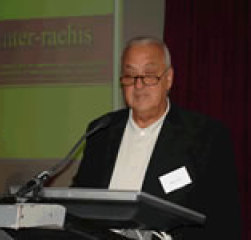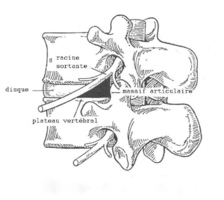
MULTICENTER STUDY OF SELECTIVE LUMBAR
ENDOSCOPIC DISCECTOMY
“The French experience”
E. GOZLAN (Paris), M. FORGERIT (Niort), D. GASTAMBIDE (Paris), B. LAVIGNOLLE (Bordeaux),O. RICART (Thionville)
PURPOSE:
To evaluate efficacy of the YESS technique (YEUNG ENDOSCOPIC SPINAL SYSTEM, WOLF) in a population suffering from a radiculopathy secondary to HNP and gather statistics from a large series of Selective Endoscopic Discectomies (SED)TM.
SUMMARY OF BACKGROUND DATA:
In 2003, a prospective assessment of 114 patients was performed. The statistical analysis showed significant patient improvement at 3 and 12 months post-operatively, as much for their quality of life as for their lumbar and radicular pain and also no major complications.
METHOD AND RESULTS:
From January 2002 to June 2004, the senior author treated 489 patients with an 88% success rate. This study included intracanal, foraminal, extra-foraminal, and extruded herniations as well as lateral stenosis. The results showed at 3 months, a significant decrease in the AVS for lumbar (61%) and radicular (77%) pain as well as in the DALLAS questionnaire (57%). The rate of complications was 1.2%. 46 patients had had previous open surgery with very similar satisfying results (87%). A second SED was carried out on 33 patients after recurrence, with also 88% satisfaction rate.
The actual multicentric study has gathered the data of 644 patients treated in 5 different centers, with the same technique. Sex ratio was M/F = 1.13. Average duration of the symptoms was 10.5 months. The rate of success, at 3 months, was estimated at 83.4% and complications at 1.08%. Most of the teams started their experience with foraminal and extraforaminal herniations with great success. The progress was all the more easier that the operator had already experience of transforaminal percutaneous techniques. Otherwise, this procedure requires a steep learning curve.
CONCLUSION:
SEDTM has evolved into successful treatment of various pathologies causing discogenic and radicular pain. This technique, evidently, is best indicated for foraminal and extra-foraminal herniations, but can be utilized for lateral stenosis and failed primary open surgery. It has also proven to be a significant alternative to conventional open surgery for all types of disc herniations, but with less invasive potential. Patient satisfaction is high, due to short recovery period and low rate of complications.

